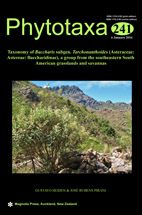Abstract
This is the first attempt to provide a taxonomic revision of a subgenus of Baccharis according to a phylogenetic framework, and under no geographic constraint. The recircumscription of Baccharis subgen. Tarchonanthoides involves the synonymization of Lanugothamnus, and the exclusion of Baccharis sect. Coridifoliae in order to keep the subgenus monophyletic. Other taxonomic changes are: Baccharis psammophila is confirmed as a synonym of B. gnaphalioides, and B. anabelae is a synonym of B. phylicifolia; the application of the latter name along with B. leucopappa and B. uleana is clarified. A lectotype is designated for the name B. uleana. Two recircumscribed sections, five new series and 13 species are accepted within the subgenus which diversified mainly in open vegetation types of southeastern South America in Brazil, Paraguay, Uruguay, and Argentina. General morphological descriptions of the infrageneric taxa are provided, as well as a taxonomic key, descriptions, data on etymology, distribution and habitats, phenology, conservation status, ethnobotany and vernacular names, and a list of specimens examined, line drawings, pictures and distribution maps for all accepted species.

